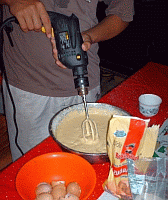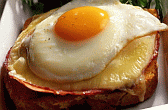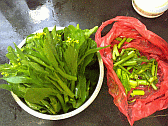|
|
| How
Do I Make ... ? |
Cheddar Cheese |
|
Cheddar cheese is one of
several hard cheeses that can be stored for a long time.
It also takes many months to mature, and blue cheese
even longer.
It is a lot easier to make soft cheese, so if this is
your first time, you may want to start with this instead?
However, soft cheese only keeps a few days, and is no
good for some types of cooking. You can find Basket
Cheese here, or read-on for Cheddar Cheese detailed
below
A large variety of imported cheese is available in China,
whilst this country also make over 200 of it's own.
You will not find Chinese made cheese in a Guangdong
supermarket, and imported ones are extremely expensive,
and availability varies.
Recipe Source:
Cheddar cheese is a semi-hard, yellow-orange cheese
that varies in sharpness. It is named after an English
village called Cheddar and is widely popular in the
United Kingdom. This article will help you to produce
your own cheddar cheese at home. |
|
| Let's get started: |

Image Source: James Folsom; Wikipedia
(Reproduced Under Collective Commons Licence) |
| |
| Things You'll Need: |
| |
• Cooking thermometer
• Cheese
Press
• 3 Cheesecloth's
• Cheesewax
• 2 gallons of milk
• 1/2
cup of cultured buttermilk
• 1
tsp liquid rennet
• 1/2 cup of
chilled water
• 4 tsp non-iodized
salt |
Method:
Step 1. Heat the milk to 88 degrees
Fahrenheit in a large pot. Stir in the buttermilk. Let
sit for one hour while maintaining the 88-degree temperature.
This can be accomplished by letting the pot sit in a
sink partially filled with warm water.
Step 2. Add rennet, which contains
a proteolytic enzyme, which coagulates milk and divides
it into curds (solids) and whey (liquid) into the cool
water. Stir the water-rennet mixture into the milk for
30 seconds. While maintaining the 88-degree temperature,
let the mixture sit for 45 minutes. During this time,
the milk will separate into liquids and solids.
Step 3. Cut the curds into small cubes
and let them sit for 20-25 minutes. Slowly stir them
for 30-45 minutes while gradually increasing the temperature
to 98 degrees Fahrenheit.
Step 4. Strain: Once the curds have
settled to the bottom, pour out the excess liquid. Strain
the curds in a colander for about 10 minutes. Pour the
curds back into the pot, add the non-iodized salt and
mix well. Let the pot of curds sit in warm water for
one hour. Stir frequently.
Step 5. Line the press with cheesecloth.
If you do not have a press, you can make one by cutting
both ends off of a large coffee can. Cheesecloth can
be improvised from a clean pillowcase. Pour the curds
into the cheesecloth. Place a wood follower on top of
the cheese and apply 15 pounds of pressure for about
20 minutes. To apply pressure, consider wrapping bricks
in aluminium foil.
Step 6. Redress the curds in new cheesecloth.
Cover with the wood follower and apply 30 pounds of
pressure for 2 hours.
Step 7. Redress the curds in new cheesecloth,
cover with the wood follower and apply 30-40 pounds
of pressure overnight or for at least 8 hours.
Step 8. Remove the curds from the cheesecloth
and allow them to air dry for 3-5 days. Turn the curds
frequently to allow all sides to dry evenly.
Step 9. Coat the curds in cheese wax.
Age for 2-6 months at 55 degrees Fahrenheit. The longer
the cheese ages, the sharper the taste will be. For
very sharp taste, age for approximately one year. Basements,
cellars and non-working refrigerators are ideal environments
for aging cheese.
Tips & Warnings
• Make your
own cheese press from a coffee can.
• Rinse
the cheesecloth well before using.
• Heavier
and longer pressing will produce a firmer cheese.
• Rennet is available in most large supermarkets
or over the Internet.
Note: Rennet
is not so easy to find in South East China, so click
here to learn how to make your own! (Excellent external
Link with picture walkthrough).
• The
differences between many cheeses are just in the cooking
temperature. Use a thermometer to be accurate.
• Once
you have mastered this, making blue cheese is fairly
simple, and recipes are given on the links below this
main article
Copyright:
Portions of this page are modifications based on work
created and shared by Google and used according to terms
described in the Creative Commons 3.0 Attribution License. |
|
| Additional Recipes
and Information: |
|
| Cheddaring |
 |
Whilst the recipe above produces
a hard cheese similar to Cheddar, it does not include
'The Cheddaring Process'. You can find this described
here
in great detail
Courtesy of Wikipedia |
|
| Recipes: |
|
eHow offer another good recipe
for Sharp
Cheddar Cheese here
This one is contributed by Ally
Heers, and is slightly different regards temperature,
weights, and extra process. If you like a sharp Cheddar,
then you should try this recipe first. |
|
| Gourmet
Sleuth |
A brilliant page featuring links
to 20 cheese recipes and video walkthrough's.
This website also has loads of other recipes and
food related information. |
|
|
FANKHAUSER'S
CHEESE PAGE
©David B. Fankhauser, Ph.D.,
Professor of Biology and Chemistry
University of Cincinnati Clermont College, Batavia
OH 45103 |
Another fantastic website that links to
dozens of cheese recipes - this guy is a real
cheese guru!
Dotted in amongst the cheese recipes are also
other for diverse things such as root beer. Enjoy! |
|
| FANKHAUSER'S
RENNET PAGE |
The same website again, this time with
a very detailed pictorial about making rennet
(Not for the squeamish or faint-hearted!) |
|
|
Related Pages:
•
How do I make Soft
Cheese (Basket Cheese)
• How
do I make Butter |
| |
This information is as supplied by ourselves, and ably
supported by our friends and various internet portals.
In addition we personally wish to thank eHow.com
and Ally
Heers for sharing with us all their excellent skills
and recipes. |
|
| Search
this Website |
|
|
| Boy
Cooking |
 |
| Béchamel Related |






|
| Descriptions |









|
|